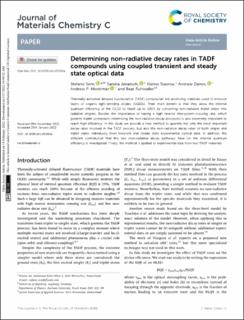Please use this identifier to cite or link to this item:
https://doi.org/10.21256/zhaw-24644Full metadata record
| DC Field | Value | Language |
|---|---|---|
| dc.contributor.author | Sem, Stefano | - |
| dc.contributor.author | Jenatsch, Sandra | - |
| dc.contributor.author | Stavrou, Kleitos | - |
| dc.contributor.author | Danos, Andrew | - |
| dc.contributor.author | Monkman, Andrew P. | - |
| dc.contributor.author | Ruhstaller, Beat | - |
| dc.date.accessioned | 2022-03-18T09:31:10Z | - |
| dc.date.available | 2022-03-18T09:31:10Z | - |
| dc.date.issued | 2022-02-14 | - |
| dc.identifier.issn | 2050-7526 | de_CH |
| dc.identifier.issn | 2050-7534 | de_CH |
| dc.identifier.uri | https://digitalcollection.zhaw.ch/handle/11475/24644 | - |
| dc.description.abstract | Thermally-activated delayed fluorescence (TADF) compounds are promising materials used in emissive layers of organic light-emitting diodes (OLEDs). Their main benefit is that they allow the internal quantum efficiency of the OLED to reach up to 100% by converting non-radiative triplet states into radiative singlets. Besides the importance of having a high reverse intersystem-crossing rate, which governs triplet conversion, minimizing the non-radiative decay processes is also extremely important to reach high efficiency. In this study we provide a new method to quantify not only the most important decay rates involved in the TADF process, but also the non-radiative decay rates of both singlet and triplet states individually from transient and steady state experimental optical data. In addition, the different contribution that the two non-radiative decay pathways have on the internal quantum efficiency is investigated. Finally, the method is applied to experimental data from two TADF materials. | de_CH |
| dc.language.iso | en | de_CH |
| dc.publisher | Royal Society of Chemistry | de_CH |
| dc.relation.ispartof | Journal of Materials Chemistry C | de_CH |
| dc.rights | https://creativecommons.org/licenses/by-nc/4.0/ | de_CH |
| dc.subject | OLED | de_CH |
| dc.subject.ddc | 621.3: Elektro-, Kommunikations-, Steuerungs- und Regelungstechnik | de_CH |
| dc.title | Determining non-radiative decay rates in TADF compounds using coupled transient and steady state optical data | de_CH |
| dc.type | Beitrag in wissenschaftlicher Zeitschrift | de_CH |
| dcterms.type | Text | de_CH |
| zhaw.departement | School of Engineering | de_CH |
| zhaw.organisationalunit | Institute of Computational Physics (ICP) | de_CH |
| dc.identifier.doi | 10.1039/D1TC05594A | de_CH |
| dc.identifier.doi | 10.21256/zhaw-24644 | - |
| zhaw.funding.eu | No | de_CH |
| zhaw.issue | 12 | de_CH |
| zhaw.originated.zhaw | Yes | de_CH |
| zhaw.pages.end | 4885 | de_CH |
| zhaw.pages.start | 4878 | de_CH |
| zhaw.publication.status | publishedVersion | de_CH |
| zhaw.volume | 10 | de_CH |
| zhaw.publication.review | Peer review (Publikation) | de_CH |
| zhaw.funding.snf | 189182 | de_CH |
| zhaw.webfeed | Photonics | de_CH |
| zhaw.author.additional | No | de_CH |
| zhaw.display.portrait | Yes | de_CH |
| Appears in collections: | Publikationen School of Engineering | |
Files in This Item:
| File | Description | Size | Format | |
|---|---|---|---|---|
| 2022_Sem-etal_Determining-non-radiative-decay-rates-TADF-compounds.pdf | 2.88 MB | Adobe PDF |  View/Open |
Show simple item record
Sem, S., Jenatsch, S., Stavrou, K., Danos, A., Monkman, A. P., & Ruhstaller, B. (2022). Determining non-radiative decay rates in TADF compounds using coupled transient and steady state optical data. Journal of Materials Chemistry C, 10(12), 4878–4885. https://doi.org/10.1039/D1TC05594A
Sem, S. et al. (2022) ‘Determining non-radiative decay rates in TADF compounds using coupled transient and steady state optical data’, Journal of Materials Chemistry C, 10(12), pp. 4878–4885. Available at: https://doi.org/10.1039/D1TC05594A.
S. Sem, S. Jenatsch, K. Stavrou, A. Danos, A. P. Monkman, and B. Ruhstaller, “Determining non-radiative decay rates in TADF compounds using coupled transient and steady state optical data,” Journal of Materials Chemistry C, vol. 10, no. 12, pp. 4878–4885, Feb. 2022, doi: 10.1039/D1TC05594A.
SEM, Stefano, Sandra JENATSCH, Kleitos STAVROU, Andrew DANOS, Andrew P. MONKMAN und Beat RUHSTALLER, 2022. Determining non-radiative decay rates in TADF compounds using coupled transient and steady state optical data. Journal of Materials Chemistry C. 14 Februar 2022. Bd. 10, Nr. 12, S. 4878–4885. DOI 10.1039/D1TC05594A
Sem, Stefano, Sandra Jenatsch, Kleitos Stavrou, Andrew Danos, Andrew P. Monkman, and Beat Ruhstaller. 2022. “Determining Non-Radiative Decay Rates in TADF Compounds Using Coupled Transient and Steady State Optical Data.” Journal of Materials Chemistry C 10 (12): 4878–85. https://doi.org/10.1039/D1TC05594A.
Sem, Stefano, et al. “Determining Non-Radiative Decay Rates in TADF Compounds Using Coupled Transient and Steady State Optical Data.” Journal of Materials Chemistry C, vol. 10, no. 12, Feb. 2022, pp. 4878–85, https://doi.org/10.1039/D1TC05594A.
Items in DSpace are protected by copyright, with all rights reserved, unless otherwise indicated.